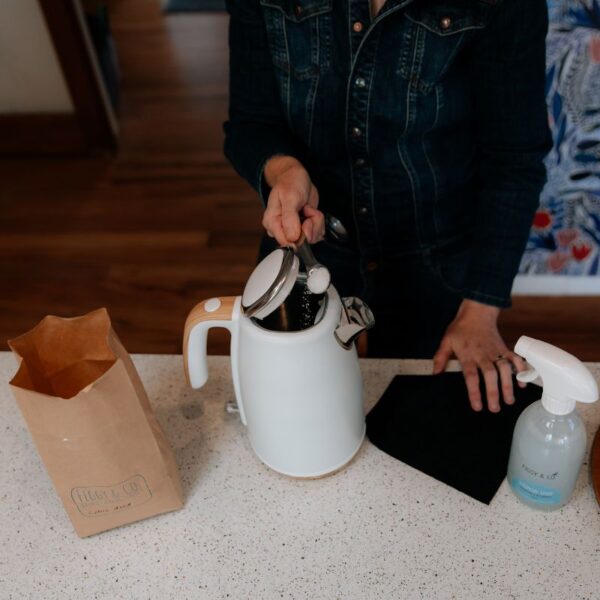How to Easily Clean & Descale your Kettle: Simple Steps for a Better Brew

It’s true, descaling your kettle is key to a sweet cuppa!
Kettle cleaning? Yip, it’s a thing! And it’s one task I’ll happily do – I love a good cuppa! In fact I might actually run on a cup of tea! Trust me, if you always have a hot drink on the go, then you’ll be chuffed with the results and it’s super easy, all you’ll need is 5 minutes! Today, we’re diving deeper than your standard wipe down. Why’s that? In one word: Limescale.
In tap water, minerals like calcium and magnesium float around – This is perfectly normal, but over time, they cling to the sides and element of your kettle and create a white build up. This white crust is called limescale. This mineral residue can affect the performance and taste of your kettle and actually make it several decibels louder! Today, we’re going to dissolve, remove those minerals and get your kettle back to its best, quietest brews!
Step-by-step Guide to cleaning and descaling your kettle
1. Unplug and Clean the Exterior:
First things first, unplug your kettle. Now, give the outside a really good clean. It might only need a wipe over with Everyday Spray and a cloth. If you have build-up, use cleaning paste. If your kettle is stainless steel, follow the grain of the metal when using cleaning paste so you don’t cause minor scratching and hazing of the metals lustre.
2. Descale the kettle Interior:
Now, onto the important part – descaling. Fill your kettle and boil it. Add 1 tablespoon of Citric Acid. Let it dissolve, then sit for about 30 minutes. Boil again. Pour out the Citric Acid mix and give it a good rinse. You are now good to go!
3. Remove Limescale Near the Lid:
If you had limescale build-up along join lines near the lid, the steam from the boiling will have made this soft enough to come off with a gentle scrape. A bamboo skewer might be helpful here.
4. Shine up Stainless Steel:
Use vinegar diluted 50/50 in a spray bottle to shine up stainless steel.
You’ll likely find the worst of the limescale near the element, as it is the heating of the water that causes the issue (in fact, all appliances that use hot water, like dishwashers, washing machines, irons, and coffee machines can be subject to this problem). But you may also find the mineral build-up near the lid and pouring filter. As a general rule, metal jugs can get mineral build-up anywhere inside, whereas plastic jugs tend to only get build-up on the base – closest to the element.
Citric Acid acid works by dissolving the water minerals from solid back down into an acidic cleaning mix so they can be easily tipped away.
Tip: If you live in one of the few areas of NZ with hard water, you may need to repeat the citric acid boil again as your mineral build-up will be thicker initially.
Why regular kettle descaling & cleaning is important

Kettles are one of those appliances we use daily or even several times a day without much thought. Over time the limescale build up can:
- Affect Taste: Limescale can taint the taste of your water, and therefore, your tea and coffee, especially if you like herbal teas or less brewed teas. If you have splashed out on a lovingly made herbal tea blend, you want it to taste its best.
- Reduce Efficiency: The limescale build-up can insulate the heating element, making it less effective and using more energy to heat the water.
- Shorten Lifespan: Consistent build-up can damage your kettle over time, shortening its lifespan, as it overworks to do it heating.
- Reduce Decibels: Limescale build up will make your kettle louder. Removing limescale can drop the decibels by 4-5dbl! The whole point of a cuppa IS a bit of piece and quiet!
Pro tips for maintaining your kettle:

- Daily Maintenance: A quick wipe over with a damp cloth when splashes happen will keep marks from becoming difficult to remove. This will also keep fingerprints and smudges to a minimum without much work.
- Avoid Abrasives: Never use steel wool or abrasive cleaners on your kettle, especially if it’s stainless steel. Metal is a tough material, but it can still be scratched with heavy scourers.
- Regular Descaling: Establish a regular descaling routine. Depending on your water hardness, this could be once a month or once every few months. Why not do your dishwasher at the same time.
- Use the Right Cloth: Always use an absorbent, streak free cloth to avoid leaving water marks behind. The Figgy eco cloth is great for this.
By following these steps, you’ll keep your kettle in peak condition, ensuring it continues to perform effectively and looks great. And if you’re like us and need a daily caffeine fix and own a Nespresso machine, check out our blog on how we tackle cleaning this machine to ensure your caffeine fix is as good, if not better, than a shop-bought coffee!
Get natural cleaning tips from our blog!
We want you to have everything you need to clean your home healthier while avoiding unwanted chemicals – and looking out for the planet too! Take a browse through our blog and learn more about natural cleaning, safe ingredients and so much more!